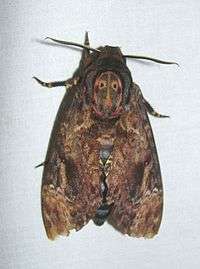Acherontia lachesis
| Acherontia lachesis | |
|---|---|
_Dorsal.jpg) | |
| Acherontia lachesis Female Dosal view | |
_Ventral.jpg) | |
| Acherontia lachesis Female Ventral view | |
| Scientific classification | |
| Kingdom: | Animalia |
| Phylum: | Arthropoda |
| Class: | Insecta |
| Order: | Lepidoptera |
| Family: | Sphingidae |
| Genus: | Acherontia |
| Species: | A. lachesis |
| Binomial name | |
| Acherontia lachesis (Fabricius, 1798) | |
| Synonyms | |
| |
Acherontia lachesis is a large (up to 13 cm wingspan) Sphingid moth found in India and much of the Oriental region, one of the three species of Death's-head Hawkmoth, also known as the Bee Robber. It is nocturnal, and very fond of honey; they can mimic the scent of honey bees so that they can enter a hive unharmed to get honey. Their tongue, which is stout and very strong, enables them to pierce the wax cells and suck the honey out. This species occurs throughout almost the entire Oriental region, from India, Pakistan and Nepal to the Philippines, and from southern Japan and the southern Russian Far East to Indonesia, where it attacks colonies of several different honey bee species. It has recently become established on the Hawaiian Islands.


Development
Eggs are laid on a variety of hostplants, belonging to the families Solanaceae, Verbenaceae, Fabaceae, Oleaceae, and Bignoniaceae, among others. Mature larvae can attain 125mm long, and occur in green, yellow, and brownish grey color forms (most commonly grey), with oblique body stripes and a prickly tail horn that is curled at the extreme tip. When molested the caterpillar throws the head and anterior segments of the body from side to side, at the same time making a rapidly repeated clicking noise, which appears to be produced by the mandibles. The larva pupates by pushing its head into the earth, burying itself, and making an ovoid chamber about 15 cm below the surface in which it sheds its skin.
Subspecies
- Acherontia lachesis lachesis
- Acherontia lachesis diehli Eitschberger, 2003
| Wikimedia Commons has media related to Acherontia lachesis. |